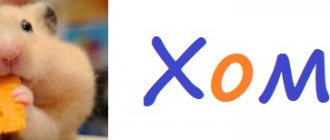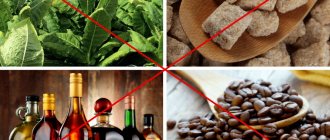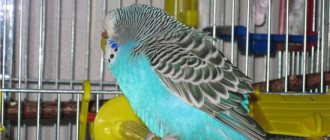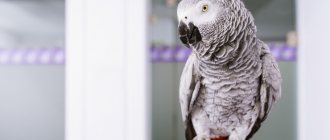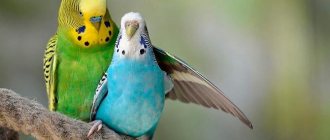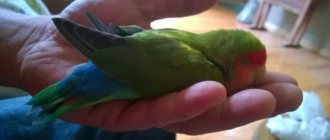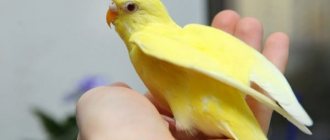Most parrot owners are concerned about the color of their pet's limbs, as birds often have bluish feet.
And the acquisition of blue color can happen either constantly or periodically without good reason.
Therefore, many lovers of exotic birds ask the question: “Why does the parrot have blue legs, and is there any reason for concern?”
- Blue: normal parrot foot color
- Blue feet in a parrot: a symptom of the disease
- Vet Answers
Manifestation of anemia
When a bird's paws are pink from birth and suddenly they suddenly change shade, darken and turn blue, it may have oxygen starvation or anemia. In addition to blue paws, the bird becomes weaker, loses weight, and develops an unsteady gait.
Anemia or anemia is when, for some reason, the level of hemoglobin in the singer’s blood decreases. This happens due to deterioration of the bone marrow. Medicines can affect the structure of the blood. There may have been a large loss of blood during the injury. Infection with infectious diseases, worms.
First of all, you need to pay attention to the conditions in which the bird is kept. Is the room sufficiently illuminated by sunlight, how clean is the cage? Is her nutrition complete and balanced? It is worth contacting a veterinarian to help improve the health of your feathered pet. Pollen will help cope with anemia. Fresh strawberries and carrots. Dandelion juice and leaves and ginseng tincture.
How to determine the cause?
It is quite difficult for a non-professional to distinguish a natural biological feature from a serious illness in small birds. But responsible breeders and owners of parrots should pay daily attention to the health and behavioral traits of their pet. If there is a refusal to fly and eat, the bird hides at the bottom of the cage and tries to peck at its paw - these are symptoms of many diseases.
Treatment of diseases of budgies.avi
Before visiting a veterinarian, you need to analyze the facts:
- Conditions for feeding and keeping the pet.
- Date and time of extremity turning blue.
- Time of appearance of atypical behavior and deterioration of well-being.
If the bird does not look sick outwardly, then you need to observe it for a couple of days. Most likely, the visit to the medical facility can be canceled.
The parrot's foot has turned black photo
Growths, peeling
Every parrot develops tumors on its legs at least once in its life. Ugly growths are a consequence of processes in the skin caused by the activity of parasites. A common infectious disease among birds is knemidocoptic mange, a scabies mite.
Microorganisms colonize unfeathered areas of the skin, make passages in them, feed on particles of the epithelium and secrete their waste products inside. Moving in the skin, the scabies mite causes unbearable itching; the bird constantly itches and pecks at the metatarsus. The skin becomes loose, peels, and the surface layer crumbles.
Salmonellosis
This is an infectious and very dangerous disease for all birds, whether wild or domestic. The disease can be identified by certain symptoms. One of them will be a change in the color of the paws; they turn black in parrots. The same thing happens with the beak. This indicates that sepsis is beginning. The bird suddenly loses weight and almost always sleeps. The abdomen and goiter enlarge. The parrot drinks a lot and refuses to eat, his droppings are runny. The body temperature rises and diarrhea begins.
Feathers protrude, wings droop, and lameness is possible. In more serious stages of the disease, damage to the nervous system, seizures and loss of orientation occur. Further damage to vital organs - kidneys, liver, spleen and heart. Egg production in females decreases and mortality among chicks increases.
Domestic birds can become infected with this disease through contact with other birds and not only. Through droppings, feather dust and droppings. If the cage and all accessories in it are not disinfected after an infected bird, the salmonellosis bacillus can persist for another two years. Carriers are both domestic animals and fleas living on them.
A chicken infected in the embryo will be a virus carrier, although it itself will not get sick. The incubation period of salmonellosis lasts no more than one week. If you discover such symptoms in your bird, you should immediately contact a veterinary hospital. Only after examination and bacteriological culture of stool can an accurate diagnosis be made.
Budgie
(lat.
Melopsittacus undulatus
) - a bird of the parrot family.
The only species in the genus is the budgerigar
(
Melopsittacus
). Individuals are noisy and talkative; they quite easily remember words and expressions, which they repeat many times when “communicating” with humans and even with other poultry. In most cases, memorized words and expressions are repeated without coherent logic.
Latin name Name of budgerigar Melopsittacus undulatus
comes from the Greek "melos" - "singing", "psittacos" - "parrot" and the Latin "undulatus" - "wavy". So his full name sounds in Russian - a singing budgerigar or, in short, a diminutive - budgerigar. Some ornithologists suggest the name Wavy Singer.
Body length 17-19.8 cm, exhibition specimens up to 21-23 cm long. Wing length 9.5-10.5 cm, tail - 8-10 cm; weight 40-45 g. Thanks to the tail, they appear much larger.
The main color of the plumage is a protective grass-green color. The front of the head and throat are yellow. On the sides of the head there are elongated purple spots, under which there are three black spots on each side of the throat. The back of the head, the back of the head and the top of the back with dark brown undulations on a yellow background. The waviness on the head changes from fine and gentle to the back into a wider and coarser one. In young birds, the wavy pattern is not as clear as in adults, and begins immediately from the cere. They retain this color until a yellow mask appears. Young birds have a much shorter tail than adults. The tail is long and stepped.
The feathers on the forehead of males have an interesting property: they fluoresce under the influence of ultraviolet rays. Under natural conditions, the presence of fluorescence plays an important role when females choose a nesting partner. An experiment was conducted: two cages with males were illuminated with daylight, but one of them was screened with glass from direct solar ultraviolet radiation. In 9 out of 10 cases, the female chose the male located in an unshielded cage.
The beak is powerful and curved. On top it is covered with a strong stratum corneum. At the base, the cere on which the nasal openings are located is strongly visible. The beak of parrots, unlike other birds, is very mobile thanks to the upper jaw, which does not grow together with the skull, but is connected to it by a tendon ligament. The upper jaw is much longer than the lower jaw. The palatine bones are well developed. This beak is a universal tool for plucking and chopping small branches, leaves, seeds and various fruits. Budgerigars use their beaks to lift and carry various objects. In addition, they use it to climb tree branches, cage bars and enclosure mesh, sometimes for defense. The tongue of budgerigars is short and thick, slightly rounded. At the tip it is covered with a stratum corneum. Most have narrow horny teeth on the inside of the beak, which, like a file, sharpen the front part of the beak and clear the grains from the husk, and are also used for picking fruits and gnawing them. In chicks, the beak is dark, in adult birds it is straw-yellow, with a greenish tint. Above the beak of birds around the nostrils there is a well-defined cere. The sex of birds is easily distinguished by the color of the wax: in a young male it is purple, in an adult it is bright blue, in a female it is blue (there is a lighter rim around the nostrils), in an adult it is blue or brown.
The neck of parrots is very mobile, since their beak performs the main grasping function. The skeleton of the body, on the contrary, is inactive, since it mainly performs a supporting function.
The flight of a budgerigar is slightly arched and resembles the flight of a swallow. When landing, the wings bend downward, making it similar to the landing of a quail.
The paws are grayish-blue and light pink, very strong and tenacious, the claws are dark blue, black or white. Each paw has 4 long, curved and rather sharp toes, 2 of which point forward and 2 point back. Thanks to this design, parrots very dexterously climb branches, walk on the ground, and can also grab various objects (including food) with their paws and carry them or hold them near their beak.
Gangrene
Another cause of blackened paws in parrots is gangrene. At the onset of the disease, the parrot's toe becomes brown. Over time, it turns black, dries out and disappears completely. During the course of the disease, the songbird holds its leg suspended, sometimes even begins to peck at it. Each bird experiences the disease individually. Some feel good, eat and chirp. Others, on the contrary, lose their appetite and lose a lot of weight. They have diarrhea and weakness. As a rule, this group of birds dies very quickly.
What does the cere of a healthy parrot look like?
What is a cere? This is the name given to the growth that is located between the eyes and beak of a bird. Like the human nose, the cere helps it breathe - it is in it that the sinuses are located. Thanks to this growth, the beak has mobility, which allows the bird to chew through solid food.
The cere is a kind of indicator of the health of the budgie. In this area, feathers do not grow and all health problems of the bird are reflected in it. This allows the bird owner to respond to its illness in time and begin treatment.
There are several signs of a normal, healthy cere:
- uniform color, without inclusions;
- smooth surface;
- absence of peeling and cracks;
- absence of inflamed growths and ulcers;
- the temperature of the growth does not differ from body temperature;
- The cere is dry to the touch, but may be slightly moist (in this case, its condition is affected by the intensity of the bird’s breathing).
An exception to the rule may be the growths of young individuals - as they grow older, they change their color. Often, chicks up to one and a half months old have black spots on their beaks, which then disappear.
The sex of a budgerigar can be easily determined by the wax - this is their advantage over other species of parrots, in which it is sometimes quite difficult to distinguish between a female and a male.
Parrot chews its paws
The owner should be wary if the pet begins to behave in an unusual way. Just because a bird is chewing on its feet does not always mean there is a problem. The parrot can press its paws and frantically peck at the skin until wounds appear. If at the same time he often scratches himself and screams, you should sound the alarm. Associated troubles: lack of appetite and sleep, loss of interest in communication and toys, constant nervousness.
Biting paws is sometimes an indicator of stress. Some parrots cannot get rid of this habit throughout their lives. If it does not cause injury, leave the bird alone. Try changing your pet's diet: add vitamins and minerals, regularly provide fresh branches and herbs, pamper him with treats.
How do you know if a parrot's paws are "too hot"?
Unlike humans, you cannot measure the temperature of a parrot's feet with a thermometer.
Rather, it comes down to getting to know your parrot and what his natural temperature is.
If your parrot is domesticated, you should sit him on your hand or finger frequently. The more often you do this, the faster you will be able to determine what their natural temperature is. From there, you can easily determine if your parrot is warmer than usual.
Most parrots have a core body temperature of around 41 degrees Celsius, with a foot temperature of 37 to 39 degrees Celsius. This is slightly warmer than the average human body temperature, so don't panic if their feet feel warmer than yours—this is normal.
You should only pay attention to this when their feet are hotter than their own norm.
Treatment of the disease
To cure naminitis, you need to:
- replace the perches (there should be at least two of them) with wooden ones (preferably with an uneven surface that helps activate blood circulation) with an appropriate diameter;
- keep the perches clean by washing them weekly;
- remove sand from the pallet and replace it with paper;
- let your pet out of the cage for walks more often, avoiding traumatic situations;
- include greens, vegetables and fruits rich in retinol in your diet.
At the first and second stages, namins are easily treated: they are treated with chlorhexidine or miramistin three times a day, and then with levomekol ointment. In case of swelling, additional hyoxyzone ointment is applied.
For old corns (but only if the skin is not broken), before applying ointments, make soda baths (dissolve 7-8 grams of soda in a glass of warm water). The birds' paws are placed in them for about 10 minutes. The procedure is repeated more often. Baths can be replaced with compresses. Baking soda will soften dead tissue and remove pus.
You should not self-medicate. To avoid the death of your pet, you should contact a veterinarian. He will conduct tests, based on which he will establish the correct diagnosis and select the optimal treatment. Timely provision of medical care significantly increases the chances of a successful recovery.
In addition, at home, inflammation of the joints, hyperkeratosis, fungal infections, and mite infestation can be confused with pododermatitis.

